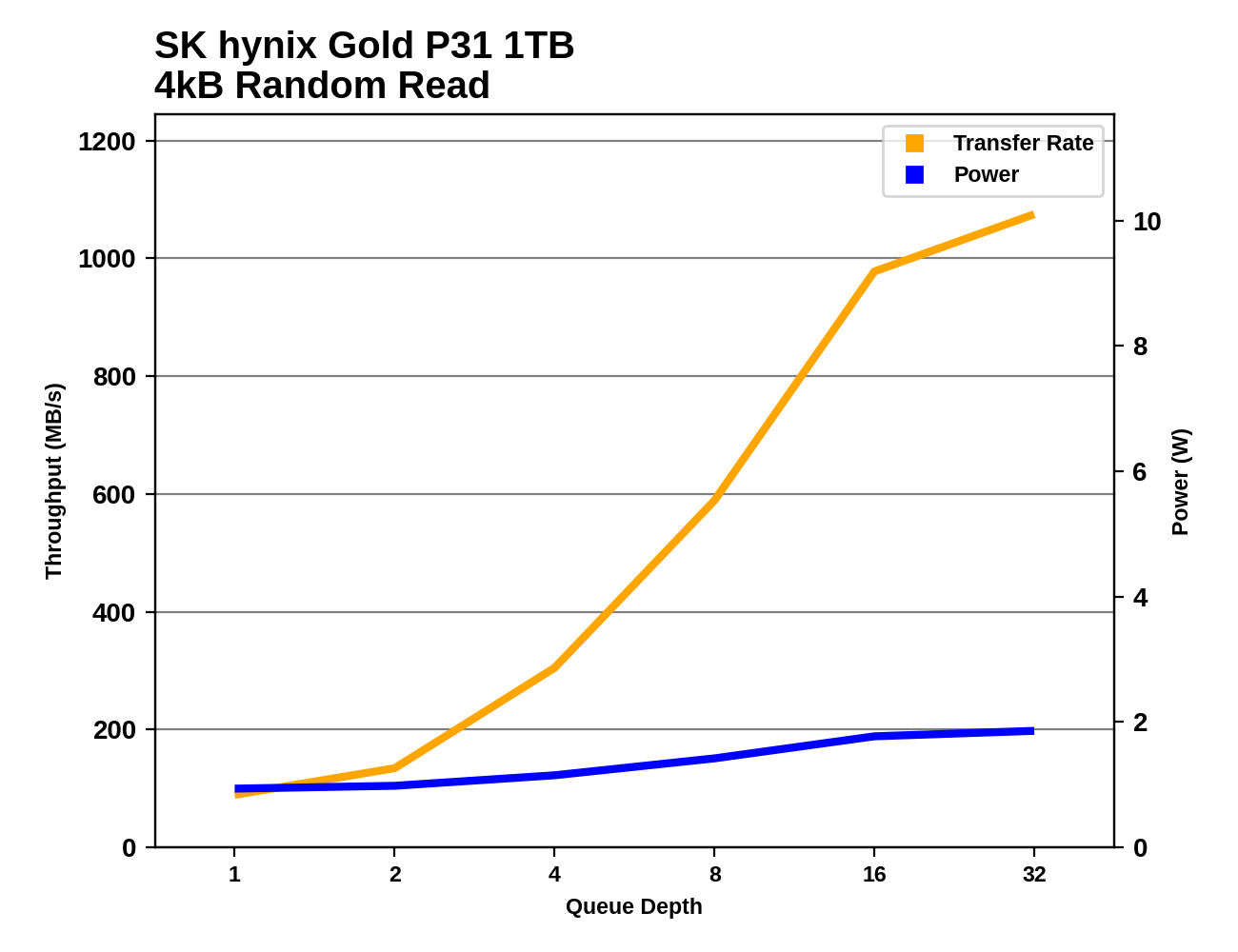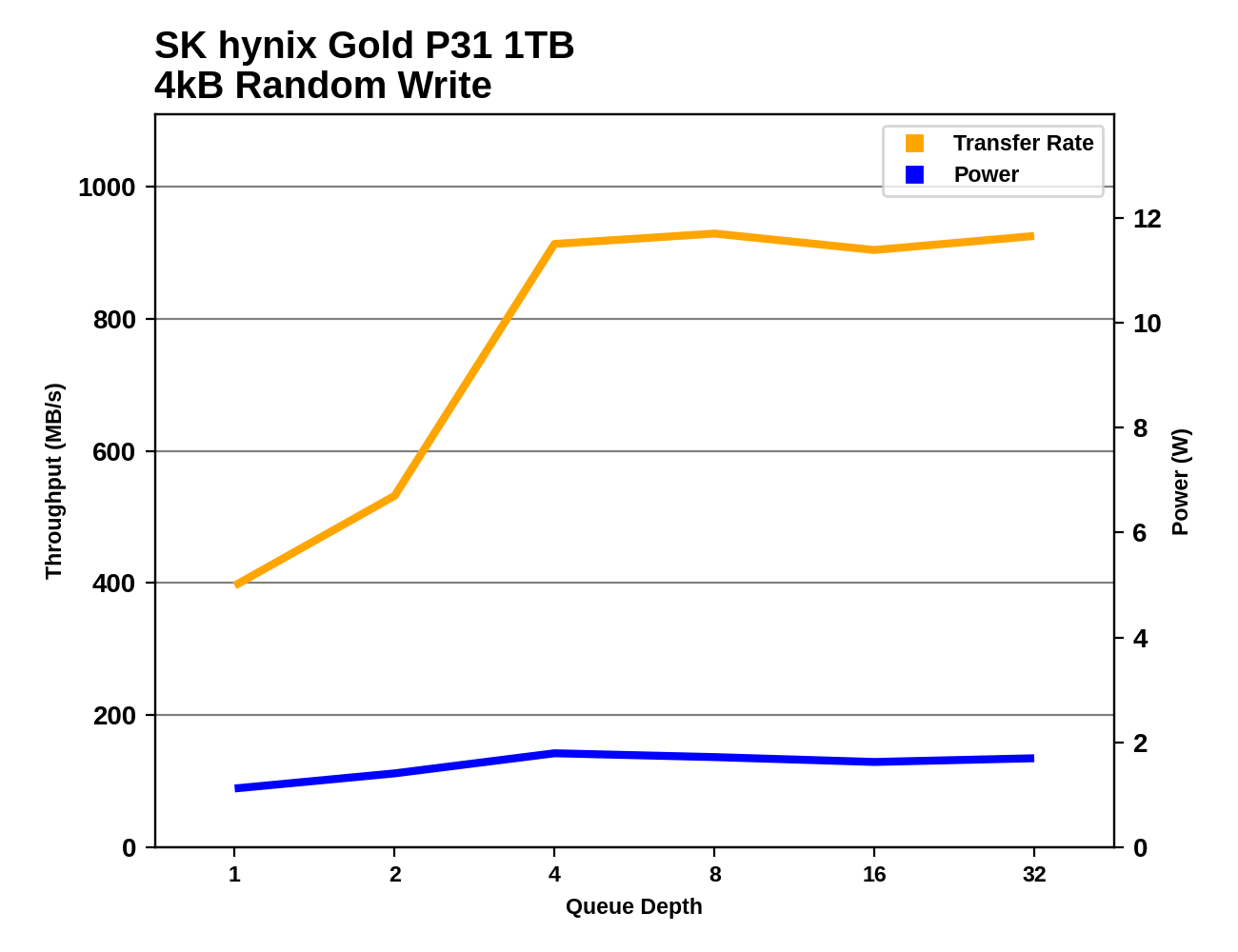The Best NVMe SSD for Laptops and Notebooks: SK hynix Gold P31 1TB SSD Reviewed
by Billy Tallis on August 27, 2020 8:00 AM ESTRandom Read Performance
Our first test of random read performance uses very short bursts of operations issued one at a time with no queuing. The drives are given enough idle time between bursts to yield an overall duty cycle of 20%, so thermal throttling is impossible. Each burst consists of a total of 32MB of 4kB random reads, from a 16GB span of the disk. The total data read is 1GB.

The QD1 burst random read performance of the SK hynix Gold P31 is similar to what we see from drives using the Silicon Motion SM2262EN controller, which has dominated this test since it hit the market.
Our sustained random read performance is similar to the random read test from our 2015 test suite: queue depths from 1 to 32 are tested, and the average performance and power efficiency across QD1, QD2 and QD4 are reported as the primary scores. Each queue depth is tested for one minute or 32GB of data transferred, whichever is shorter. After each queue depth is tested, the drive is given up to one minute to cool off so that the higher queue depths are unlikely to be affected by accumulated heat build-up. The individual read operations are again 4kB, and cover a 64GB span of the drive.

On the longer random read test that reaches into higher queue depths, the Gold P31 pulls narrowly ahead of the SX8200 Pro to set a new record for TLC-based SSDs.
 |
|||||||||
| Power Efficiency in MB/s/W | Average Power in W | ||||||||
The power draw of the Gold P31 is only a hair above that of its SATA sibling, the Gold S31. But the P31 is delivering almost three times the performance of that drive, and twice the performance per Watt of the next most efficient drive.
 |
|||||||||
The Gold P31 delivers class-leading performance across the entire range of queue depths covered by this test. Its performance is starting to taper off by QD32, but at that point it has caught up with the throughput of the Optane 905P. The widest margins over other TLC SSDs are around QD8 through QD16. Power consumption remains very low throughout the test, not even reaching 2W at QD32 - that 2x efficiency advantage over the competition remains just as true at high queue depths.
Plotting the P31's results against the entire benchmark database shows that the P31 stakes out new territory. The closest competition on the power/performance landscape are the tiny Intel Optane Memory M.2 drives, and at QD4 or higher all the other flash-based SSDs need considerably more power to deliver the same performance (at QD4 and below, the P31 is still in SATA performance territory where there are more low-power competitors).
Random Write Performance
Our test of random write burst performance is structured similarly to the random read burst test, but each burst is only 4MB and the total test length is 128MB. The 4kB random write operations are distributed over a 16GB span of the drive, and the operations are issued one at a time with no queuing.

The burst random write performance of the Gold P31 is lackluster: slower than most high-end NVMe drives, though actually still a bit faster than the Samsung 970 EVO Plus.
As with the sustained random read test, our sustained 4kB random write test runs for up to one minute or 32GB per queue depth, covering a 64GB span of the drive and giving the drive up to 1 minute of idle time between queue depths to allow for write caches to be flushed and for the drive to cool down.

On the longer random write test that includes some higher queue depths, the high-end NVMe drives mostly have fairly similar scores, and the P31 falls in the middle of the pack for performance.
 |
|||||||||
| Power Efficiency in MB/s/W | Average Power in W | ||||||||
Once again, the power consumption of the Gold P31 is more in line with low-power SATA or DRAMless NVMe drives, even though it offers high-end performance. This time, the efficiency score isn't quite twice that of the next best competitor, but a 75% improvement is still impressive.
 |
|||||||||
The performance profile for the Gold P31 on the random write test is fairly typical: fill performance is reached at QD4, and performance is mostly steady through the rest of the test. The P31 starts out slightly slower at QD1, but at full speed it is definitely competitive.
Comparing the Gold P31's random write performance against our entire database of results shows it standing out even more clearly than it did for the random read results. The QD1 random write performance is already beyond the reach of SATA drives, and none of the other NVMe drives we've tested operate at such low power levels.












80 Comments
View All Comments
Luminar - Tuesday, September 1, 2020 - link
Kapton tape works better. Those small SSDs can get pretty hot and good Kapton tape won't leave residue.Luminar - Thursday, August 27, 2020 - link
Why didn't the WD blue sn500 get included?Billy Tallis - Thursday, August 27, 2020 - link
Mainly because I only have a 250GB sample of that, and that's not a particularly fair or relevant comparison against 1TB drives. If I had the 1TB SN550 I would definitely have included that.cfbcfb - Sunday, August 30, 2020 - link
Not even in the ballpark. The read and especially write speeds are in the top 3 of ALL nvme SSD's, and this one uses half the power and makes half the heat, for just a few dollars more than the Blue. In fact, in most use cases, its faster than the WD Black for less money.DZor - Thursday, August 27, 2020 - link
All this does not matter cause 1TB drives are for long time in USD 130 - 150 range. For PCIe 3. PCIe 4 is some USD 50 more expensive.Except for "hi end" once like 970 Pro.
Gigaplex - Thursday, August 27, 2020 - link
Why doesn't it matter? It's a good drive in this price range, and to many people it's pretty affordable.plopke - Thursday, August 27, 2020 - link
I am curious to try SKHynix consumer drives out myself. But unless you are a OEM like dell there is no support software to check firmware or update firmware , so if there is ever an issues they have no framework at all to fix anything? This drive isn't even mentioned on their weird ssd webpage?I mean sandisk-WD/samsung/crucial/ADATA/Kingston , ALL OF THEM have a ssd manager client and software in place just in case firmware updates are needed?
plopke - Thursday, August 27, 2020 - link
PS I mean someone please proof me wrong , i actually was kinda interested in getting one of these but then I saw their product page and it was horrible and alarms bells started to ring when I couldn't find any support software at all.Billy Tallis - Thursday, August 27, 2020 - link
Their consumer SSD site is definitely a work in progress, but that's not too surprising since they only have two retail products at the moment and no real history in this market.I wouldn't be too worried about software. Aside from firmware updates, there's really not much point in vendor-specific tools and I wish they would all just lobby Microsoft to make decent vendor-neutral storage admin tools.
And I don't think firmware updates are as important as you seem to think. They're pretty uncommon these days and usually don't matter much unless your system has a weird incompatibility that a SSD firmware update can fix. If SK hynix does need to push out an update for this drive, I'm sure they'll be able to come up with a delivery method. Running an extra application to give you a firmware update notification on the outside chance you ever need such a notification is a bit silly.
damianrobertjones - Thursday, August 27, 2020 - link
Well, I'm not a copy editor, but i could prove you wrong if I tried.